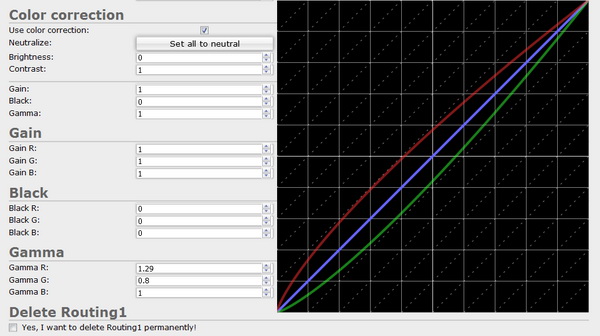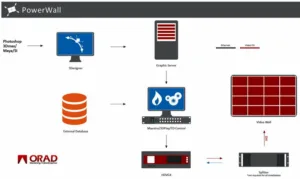Orad Hi-Tec Systems Ltd. (Kfar Saba, Israel) introduced its HDVG4 videowall controller at NAB 2013. This controller is targeted at high-end studio videowall applications, especially on-set studio applications. A single HDVG4 platform can distribute video to up to 16 displays. In an 8 x 2 configuration it can provide a total pixel count of 15,360 x 2,160 (16K), which makes 4K video with 4096 x 2160 pixels look puny.
Key Features of the HDVG4 platform include:
- Single box provides all the video for the wall – no clustering required
- 8x 3G-SDI or 16x HD-SDI genlocked outputs
- Up to 16 HD or 16 SD video insertions – combine live video with graphics
- Can generate 4K, 1080p, 1080i, SD and IP stream outputs
- Support for video clips in many formats (including avi, qt, dv, mxf, wmv)
- Content creation with 3Designer authoring software
- Versatile control with TD Control, 3DPlay or Maestro environments
Block diagram of the complete system, called a PowerWall by Orad
Since the HDVG4 platform is targeted at on-set use in a studio, it is important that it looks right not just to human viewers but to studio television cameras as well. All the pixels in a 15,360 x 2,160 video wall array are independent – the system does not just show upscaled 2K or 4K video across the complete display. This allows studio cameras to zoom in on things, such as newscasters, without worrying about the resolution of the displays behind them. In addition, by running from a single HDVG4, all on-screen elements (tickers, videos, animated items, etc), will remain synchronized across the whole of the video wall, with no tearing visible on any sections of the output.
The PowerWall system can optionally include Interact, allowing presenters to control and direct the content on their touch screens, video walls and other input devices, helping them engage with their viewers. Interact supports countless gestures including; rotating, scaling, moving, dragging, tapping, holding, drawing, highlighting, etc. Interactive elements can also possess physical properties such as mass and inertia, giving a new level of feedback to the interactive graphics. Interact supports single, dual and multitouch displays from a variety of manufacturers, allowing broadcasters to choose the device that best suits their production’s style and budget.
On January 27th 2015, Orad announced that its video wall solutions had been enhanced with a layout configurator, allowing operators to create or edit the layout of their HDVG video rendering signals from a web browser. The configuration changes are updated in real time so all changes can be observed live.
 Color Correction screen on the new Orad Layout Configurator for its PowerWall system
Color Correction screen on the new Orad Layout Configurator for its PowerWall systemThe layout configurator allows for quick setup and configuration of the layouts that will be used for any type of production. Easily adapting to the difficult aspect ratios and arrangements that are possible with studio wall configurations, the layout configurator can adjust the placement and orientation of the signals being sent from the HDVG4 to the displays. Built-in color correctors for each output help control the look of the content on the wall without requiring expensive external systems or technical adjustments on the wall itself.
Accessible from any PC on the same network as the Orad HDVG4 video rendering platform, a user simply opens a browser and connects to the HDVG in order to change the layout. New layouts can be quickly created either from scratch, or based upon an existing layout.
All operations carried out in the layout configurator are done live when RenderEngine is running. The user has immediate feedback regarding the changes that are being made, and no system restarts are required. Layouts can be switched between productions in the event that the same system is connected to different wall layouts. – Matthew Brennesholtz

